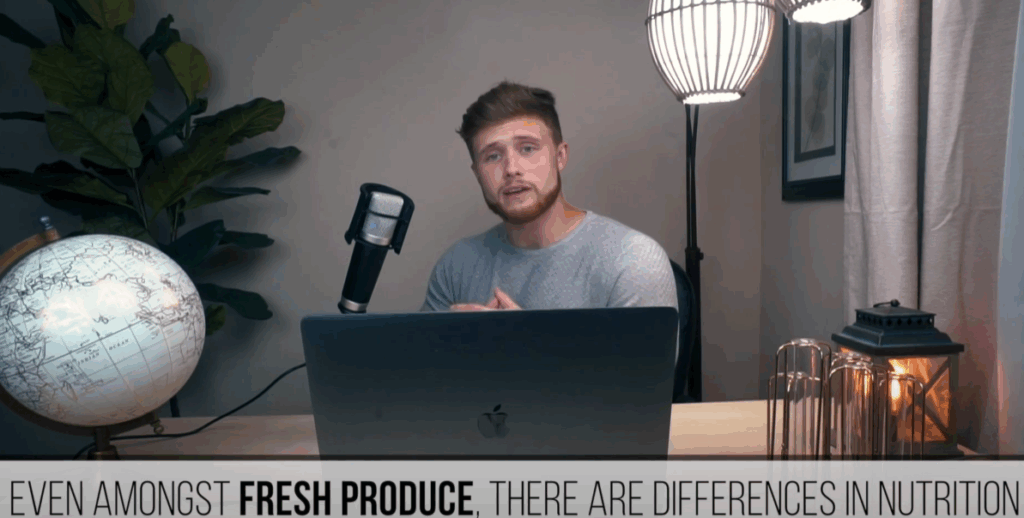In the world of nutrition and fitness, one debate seems to pop up time and time again: Are fresh fruits and vegetables always better than frozen ones? At first glance, the answer seems obvious—“fresh” just sounds healthier, doesn’t it?
But as someone who’s been coaching athletes, bodybuilders, and everyday clients for over two decades, I can tell you this: when it comes to nutrition, the truth is rarely that simple. Let’s unpack the science, bust some myths, and see how both fresh and frozen produce really stack up—especially if your goal is optimal health, muscle gain, or fat loss.

Why People Believe “Fresh Is Best”
The widespread belief that fresh produce is more nutritious often comes from the idea that “fresh” equals “less processed.” And it’s true—highly processed, calorie-dense, and nutrient-poor foods contribute to poor dietary habits. But not all processing is bad. In fact, some processing methods can preserve and even enhance nutrient availability.
Take freezing, for example. It’s a form of preservation that locks in nutrients at peak ripeness. This can actually result in better retention of vitamins and minerals compared to fresh produce that sits on a truck, a shelf, and finally your fridge for days or even weeks.
Understanding “Processing” in Nutrition
Not all processing is created equal. There’s a world of difference between flash-freezing blueberries and making a frozen microwave pizza.
Here’s a breakdown of processing levels:
- Minimal processing: washing, chopping, or freezing produce.
- Moderate processing: canning with some added preservatives.
- Highly processed: packaged meals with additives, fillers, and synthetic ingredients.
Frozen fruits and vegetables typically fall under the first two categories—meaning they retain most (if not all) of their original nutritional value. On the other hand, frozen meals or sugary fruit snacks? Those belong in the “avoid” pile.
What the Research Really Says
Let’s dig into what science has to say about nutrient retention in fresh vs. frozen produce.
A number of studies have compared the vitamin and mineral content of produce in various forms—fresh, frozen, and “fresh stored” (i.e., fresh but kept in the fridge for 5+ days). One consistent finding? Storage time plays a major role in nutrient loss.
For instance, Vitamin C, a water-soluble and fragile nutrient, tends to degrade quickly after harvest. That means a “fresh” head of broccoli that’s been shipped cross-country and sat in your refrigerator for a week may actually contain less vitamin C than a bag of frozen broccoli that was flash-frozen shortly after harvest.
Here are a few specific findings:
| Produce Item | Higher Nutrient In |
|---|---|
| Broccoli (Vitamin C) | Fresh = Frozen |
| Green peas (Beta-carotene) | Frozen > Fresh |
| Spinach (Folate) | Frozen > Fresh |
| Corn (Vitamin C) | Frozen > Stored Fresh |
These differences may seem small, but they matter—especially when you’re counting on your food for performance and recovery. If you’re someone trying to build muscle, lose fat, or support athletic performance, micronutrients like these play a massive role in metabolic efficiency, hormonal balance, and immune function.

When “Fresh” Isn’t Actually Fresh
Most consumers don’t realize that produce labeled as “fresh” in supermarkets can be anywhere from 3 days to 3 weeks old by the time you buy it. After harvest, fruits and vegetables often undergo:
- Long transportation times,
- Prolonged storage in distribution centers,
- Sitting on shelves exposed to light and fluctuating temperatures.
Each of these steps contributes to nutrient breakdown.
Compare that to frozen produce, which is usually:
- Picked at peak ripeness (when nutrients are highest),
- Blanched (briefly boiled or steamed to kill bacteria),
- Flash-frozen within hours.
This rapid freezing process helps preserve taste, texture, and nutritional quality—often making frozen produce a more reliable option than the “fresh” variety.
What About Canned Produce?
Canned fruits and vegetables are often dismissed entirely—but let’s clear up another myth. While some water-soluble nutrients (like vitamin C or B vitamins) may degrade during the canning process, other nutrients, like lycopene (in tomatoes) or beta-carotene (in carrots), can actually become more bioavailable after heat treatment.
So don’t write off canned produce entirely—just be mindful of sodium levels and added sugars in some products. Look for “no salt added” or “packed in water” options when possible.
Bottom Line: It’s About What You’ll Actually Eat
Here’s a truth I share with every client, whether they’re a beginner or a seasoned athlete: The healthiest fruits and vegetables are the ones you’ll actually eat—consistently.
There’s no point in spending money on fresh kale if it wilts in your fridge and ends up in the trash. If frozen or canned vegetables are more convenient for your lifestyle, budget, or cooking habits, then go for it. You’re still making a nutritious choice.

Practical Takeaways for Health-Conscious Eaters
Let’s wrap this up with some actionable advice based on both research and real-world coaching:
✅ 1. Use a mix of fresh, frozen, and canned
Diversity is key. Rotate between produce types based on your cooking needs and seasonality.
✅ 2. Buy frozen when it’s out of season
If berries or greens are out of season (and expensive), opt for frozen to save money and get better nutrient density.
✅ 3. Watch your storage times
If you do buy fresh, try to eat it within 3–5 days. Beyond that, nutrient loss starts to climb.
✅ 4. Cook smart
Steaming or microwaving is generally better than boiling when it comes to retaining water-soluble nutrients. Quick stir-frying is another solid option.
✅ 5. Focus on variety, not perfection
Red, green, orange, purple—eat the rainbow. That’s the simplest way to ensure you’re covering your vitamin and mineral bases.
Final Word: Don’t Let Food Myths Derail Your Progress
In the fitness world, it’s easy to fall into the trap of overanalyzing every little detail. But in the case of fresh vs. frozen produce, the research is clear: frozen fruits and vegetables are just as nutritious—sometimes even more so—than their fresh counterparts.
As long as your diet is rich in plant-based foods, varied in color, and consistent over time, you’re doing it right. Whether it comes out of a fridge, freezer, or can, what matters most is that it ends up on your plate.



